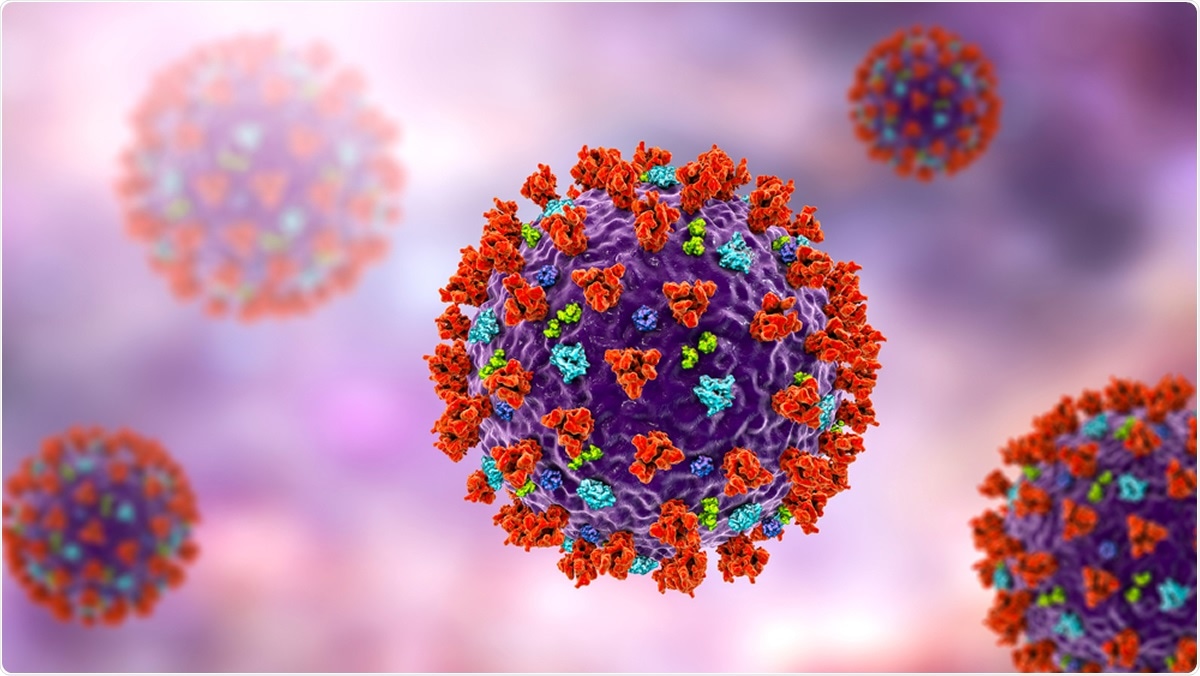Early in the pandemic, scientists uncovered the role of the ACE2 receptor in SARS-CoV-2, the virus that causes the coronavirus disease (COVID-19). The severe acute respiratory syndrome coronavirus 2 (SARS-CoV-2) spike protein and the angiotensin-converting enzyme 2 (ACE2) receptors act as a lock and key for cell infection.

SARS-CoV-2 coronavirus, 3D illustration showing surface spikes of the virus Glycoprotein S (red), Hemagglutinin-esterase (light blue), M protein (light green), E protein (dark blue). Image Credit: Kateryna Kon / Shutterstock
Now, a team of researchers at the Indian Institute of Science Education and Research (IISER) Kolkata has explained the different dynamic structures of the SARS-CoV-2 spike protein, which acts as the molecular machine that permits the entry of the novel coronavirus into cells.
The study, published in the Journal of Physical Chemistry Letters, highlights show their findings can help in formulating and developing effective vaccines against the virus, which has now infected more than 27.24 million people across the globe.
What is the spike protein?
One of the describing features of SARS-CoV-2 is the protein spikes that cover the surface, which the virus uses to bind with and enter human cells.
Analyzing the structure of these spikes could provide clues about the virus’ evolution, and they can act as the key to the development of effective vaccines.
Most of the vaccines being developed across the globe, where some are now in the last phase of clinical evaluation, work in a basic code – revealing the body to the spike protein, which acts as protrusions seen on the outer surface of the virus, to trick the body into believing that it has been attacked by a pathogen, hence, inducing an immune response.
Since then, scientists study the three-dimensional structure of the spike protein, and they are learning about the spike protein and how they can target this part of the virus, which is the key to infecting cells.
Dynamic asymmetry
The spike protein of SARS-CoV-2 is a smart molecular machine that initiates the entry of the coronavirus into the cell, causing COVID-19. The researchers used a symmetry-information-loaded structure-based Hamiltonian, using recent Cryo-EM structural data to determine the conformational energy landscape of the perfusion spike protein.
“The study finds the 2019-nCoV prefusion spike to adopt a unique strategy by undertaking a dynamic conformational asymmetry that results in two prevalent asymmetric structures of spike where one or two spike heads rotate up to provide better exposure to the host-cell receptor,” the researchers wrote in the paper.
The team also explained that the stability of every biomolecular structure is controlled by a “free energy” parameter, which is essential in understanding how the molecule responds to its surroundings. The scientists described the free energy profile for the various structures of the SARS-CoV-2 spike protein.
The constancy of every biomolecular structure is controlled by a parameter called ‘free energy,’ which is fundamental in understanding how the molecule will react with its surroundings. The spike protein contains three combined chains of amino acids, which are considered the building blocks of proteins.
When these amino acids interact with each other, they create a set of dynamics within spike proteins, which the scientist described as the “dance of the spike protein.”
In the study, the researchers defined the states wherein these spike proteins are most likely to help the virus bind to the ACE2 receptor sites. The three states induce the immune response, so having a better understanding of these dynamics can help in developing effective vaccines for protection against the infectious disease.
“The dynamic asymmetry induced by the identified unique interchain interactions in this study highlights a different mechanism for SARS-CoV-2 S stabilizing more up conformation,” the authors wrote.
“Although in the current situation developing diagnostics and antiviral therapies are of utmost priority, we believe the present structure-based-model-derived information at the microscopic interaction level might provide deep insight into design effective decoys or vaccine to fight 2019-nCoV infection,” they added.